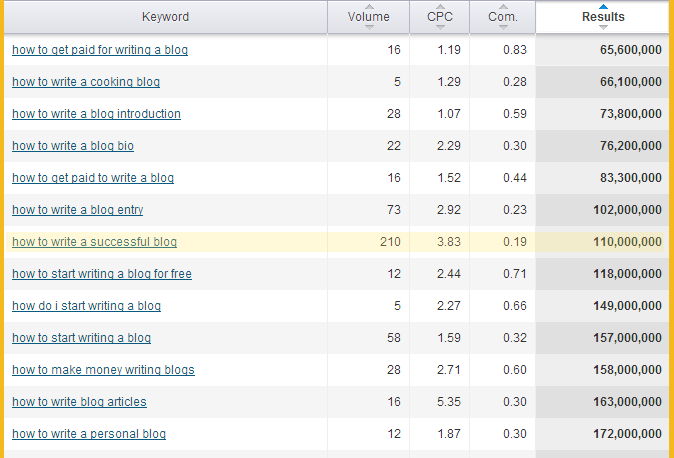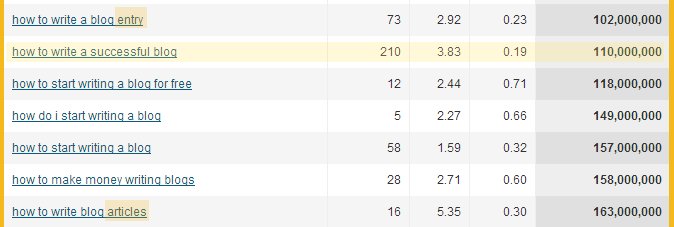Believe it or not, the title is the most important element of the blog post. It is the weighted equivalent of the subject line of an email marketing campaign. If you do not have a compelling title, then no one will ever read your blog post.
Marketing Channels that get Impacted by the Blog Post Title
SEO – The title shows up in Google results. It has to win the competition with the other titles around it.
Social Media – The post title will be come up on status updates from visitors sharing your post on social media channels. It will determine the virality of the social share.
Blog Subscribers – The blog title will be the subject line of post updates, and it will determine whether the email is opened.
Return Visitors – The title will show up on your home page, which will drive the visitor deeper into your blog.
Keyword Brainstorming for Root Titles
Before you write a word of your blog post, you should identify the root title of the post. You will find your root title by having a keyword brainstorm session. The best tools for keyword brainstorming are Google Adwords Keyword Planner and SEM Rush Keyword Research Tools. The goal is to identify a topic that is in demand, which you can compete for. This allows you to write with the purpose of increasing organic traffic to your blog. A keyword brainstorming session should produce several root titles that can be used for the current and future posts.
Step 1 – Start Your Search Broadly
You want to start your search with a one or two word keyword phrase. This allows you to identify multiple topics. I will begin my brainstorming session example by conducting keyword research for the term “blog post.”
Below are the top keyword research results for the two word phrase “blog post.”

As I look through the keywords above I can identify several good root titles to write articles on, but this is the one that I will focus on for the example:
How to Write a Blog Post
Step 2 – Focused Search and Competition Analysis
After the root title has been identified, your focus moves to identifying longer tailed keyword searches with decreased competition. To have financial success as a blogger, you need to focus on keyword phrases that you can rank for on Google. The focused keyword search should identify the lowest hanging fruit to pursue in your title.
The snapshot below shows a focused search for the root title, “How to Write a Blog Post.” The keyword phrases are ranked by the least to the greatest number of Google results. This is the simplest way to identify long tailed keyword phrases with the least amount of competition.

The lowest competition with the highest search volume from the data above is:
How to Write a Successful Blog
At this point, you will look at the remaining keyword phrases to identify additional words that you can add to the title. In this example, I see that “entry” and “article” are used in two of the other searches.

This leaves me with the final version for that title:
“How to Write a Successful Blog Article Entry”
The additional terms do not take away from the impact of the title. The add on terms increase the number of keyword variations for your title that will be indexed by Google.
How Many Characters Should a Title Be
There are two big numbers to know in regards to character count and blog titles.
Google Title Character Count – Less than 70. This is the amount that will show up in the Google search results. Anything more will be cut off.
Email Subject Line Character Count – Less than 50. This is the amount that will show up in the subject line for the vast majority of email service providers.
The best practice for blog title length is to have it between 35-50 characters. This allows your titles to not be cut off in email subject lines, and it leaves you with 20 characters to have your blog name show in Google results.
For example the title of this blog is 38 characters:
How to Write the Best Blog Post Titles
My blog domain name is 18 characters:
BrandonGaille.com
In Google, the title will show up as:
How to Write the Best Blog Post Titles | BrandonGaille.com
In the long run, you are going to want to build a brand name that people recognize. If you brand name is showing up next to all of your titles in Google, then it will increase the total brand recognition for your blog.
The Two Most Effective Styles of Titles
Question and Answer Titles
The initial keyword research naturally brought us to a title using the “question and answer” style. This is one of the two most effective title styles that achieve the highest click through rates.
These titles are all in question format, and the post conveys the answer. I prefer to use this style only when the keyword research shows a significant volume for the specific question. You can also start your keyword research using a “question word” combined with a single keyword related to your topic. This will give you a list of questions that people are searching for around that topic.
Here is a list of the “questions words.”
What
When
Where
Which
Who
Whom
Whose
Why
Wow
Examples of Question and Answer Titles
How to Make Money with a Blog
Why Should I Start My Own Blog
What is the Best Free Blog Site
Where Can I Find Images for My Blog
Numbered Titles and Lists
If you are not driven to a keyword phrase in a question form, then you should craft a “numbered title.” A numbered title is simply a title that has a number in it. The best practice is to include the number at the front of the title.
Examples of Number Titles
15 Ways to Make Money with Your Blog
23 Incredible WordPress Statistics and Trends
List of 11 Fonts to Use for Your Blog
5 Most Popular WordPress Form Plugins
The numbered title has a psychological effect on the viewer, which I like to refer to as the “Acceptable Chunking Effect.” Essentially, the viewer perceives that the post can be easily scanned to identify bite sized chunks of quality information. Without the number, the viewer can be intimidated by a perception of an in depth article that they do not have the time to read.
Adding Adjectives to The Title
Adjectives play a supportive role in increasing the click through rate by another 5-10%. A nicely placed adjective can create a perceived sense of excitement that might not be attained without it.
Here is an example of a few titles with and without adjectives:
8 Characteristics of a CEO
8 Most Valuable Characteristics of a Great CEO
20 Apps for Entrepreneurs
20 Remarkable Apps for Entrepreneurs
6 Business Obstacles for Startups
6 Biggest Business Obstacles for Startups
7 Travel Tech Gadgets for Business
7 Best Travel Tech Gadgets for Business
Here is a list of some of the best adjectives that you can add to a blog title:
Great, Greatest
Good
Best
Most Popular
Most Used
Key
Vital
Essential
Important
Top
Big, Biggest
Terrific
Exceptional
Must See
Eye Opening
Jaw Dropping
Amazing
Profound
Compelling
Marvelous
Perfect
Unbelievable
Effective
Coolest
Impressive
Significant
Awesome
Extraordinary
Remarkable
Astonishing
Brilliant
Here is a nice slideshow going over some more examples of great blog post titles.
About The Author
Although millions of people visit Brandon's blog each month, his path to success was not easy. Go here to read his incredible story, "From Disabled and $500k in Debt to a Pro Blogger with 5 Million Monthly Visitors." If you want to send Brandon a quick message, then visit his contact page here.
Although millions of people visit Brandon's blog each month, his path to success was not easy. Go here to read his incredible story, "From Disabled and $500k in Debt to a Pro Blogger with 5 Million Monthly Visitors." If you want to send Brandon a quick message, then visit his contact page here.
